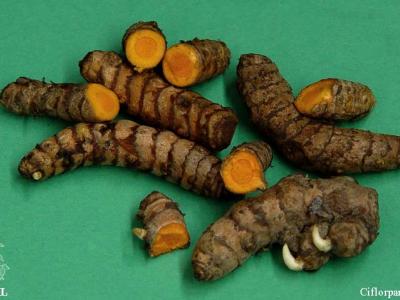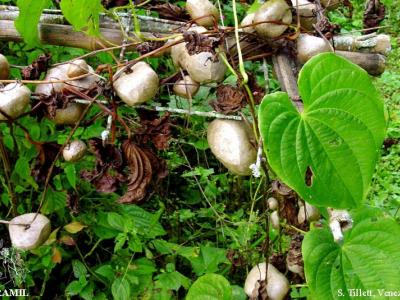(dans les territoires avec usage significatif TRAMIL)
République dominicaine:
- bejuco caro
Haïti:
- lyann mòl
feuille, passée au feu, en application locale1-2
Selon l’information disponible :
L’emploi topique contre les abcès, l’affection ganglionnaire et les furoncles est classé REC sur la base de l’usage significatif traditionnel documenté par les enquêtes TRAMIL, les études de validation, les études de toxicité, d’irritabilité topique et l’information scientifique publiée.
Toute application topique doit se conformer à de strictes mesures d’hygiène pour empêcher la contamination ou une infection surajoutée.
Si l'état du patient se détériore, ou si l’abcès, l’affection ganglionnaire ou les furoncles persistent au-delà de 5 jours, il faut consulter un médecin.
L’emploi oral contre le rhume, la toux et la grippe est classé REC sur la base de l’usage significatif traditionnel documenté par les enquêtes TRAMIL et les études de toxicité.
Si l'état du patient se détériore, ou si le rhume, la toux et la grippe persistent au-delà de 5 jours, il faut consulter un médecin.
Contre-indiqué chez les personnes en dépression nerveuse ou sous traitement antidépressif.
Ne pas employer pendant la grossesse car susceptible de provoquer un avortement, ni pendant l’allaitement, ni avec des enfants de moins de 5 ans.
Pour l’emploi sur des abcès ou contre les affections ganglionnaires :
Laver la lésion avec de l’eau bouillie et du savon. Laver la feuille soigneusement, la chauffer légèrement au feu et appliquer 5-10 grammes de matériel végétal directement sur la zone affectée. Couvrir avec une compresse ou un linge propre et changer 2 fois par jour.
Contre les furoncles :
Laver la lésion avec de l’eau bouillie et du savon. Appliquer une quantité suffisante de feuille lavée et broyée sur la zone affectée. Couvrir avec une compresse ou un linge propre et changer 2 fois par jour.
Pour l’emploi contre le rhume, la toux ou la grippe :
Préparer une décoction avec 30 grammes de feuilles dans 4 tasses (1 litre) d'eau, faire bouillir pendant 10 minutes dans un récipient couvert. Laisser refroidir, filtrer et boire 1 tasse 3 fois par jour.
Toute préparation médicinale doit être conservée au froid et utilisée dans les 24 heures.
1 WENIGER B, ROUZIER M, 1986
Enquête TRAMIL. Service Oecuménique d'Entraide SOE, Port au Prince, Haïti.
2 GERMOSEN-ROBINEAU L, GERONIMO M, AMPARO C, 1984
Encuesta TRAMIL. enda-caribe, Santo Domingo, Rep. Dominicana.
3 WENIGER B, SAVARY H, DAGUIHL R, 1984
Tri phytochimique de plantes de la liste TRAMIL. Laboratoire de chimie des substances naturelles, Faculté de Médecine et de Pharmacie, Université d'Etat d'Haïti, Port au Prince, Haïti.
4 PINEDA M, 1990
Fitoquímica de algunas plantas TRAMIL. Laboratorio enda-caribe, Santo Domingo, Rep. Dominicana.
5 GARCIA MD, QUILEZ AM, SAENZ MT, MARTINEZ-DOMINGUEZ ME, DE LA PUERTA R, 2000
Anti-inflammatory activity of Agave intermixta Trel. and Cissus sicyoides L., species used in the Caribbean traditional medicine. J Ethnopharmacol 71:395-400.
6 BELTRAME FL, SARTORETTO JL, BAZOTTE RB, CUMAN RN, CORTEZ DAG, 2001
Estudo fitoquímico e avaliação do efeito antidiabético do Cissus verticillata L (Vitaceae). Química Nova 24:783-785.
7 BARBOSA WLR, SANTOS WRAS, PINTO LN, TAVARES ICC, 2002
Flavonóides de Cissus verticillata e a atividade hipoglicemiante do chá de suas folhas. Rev Bras Farmacognosia 12:13-15.
8 DE SOUSA C, DE PAIVA T, BEZERRA P, FALCÃO J, OLIVEIRA F, SILVEIRA E, FERREIRA J, FREIRE D, RODRIGUES M, CLEA F, DE SOUSA F, DE CASTRO D, DA ROCHA S, DE BARROS G, 2007
Anti-diabetic activity of a fraction from Cissus verticillata and tyramine, its main bioactive constituent, in alloxan-induced diabetic rats. American J of Pharmacology and Toxicology 2(4):178-188.
9 STANDLEY PC, 1937
The flora of Costa Rica, Pt. I. Bot Serv Field Mus Nat Hist 18(391):398.
10 MARTINEZ MJ, LOPEZ M, BOUCOURT E, FUENTES V, MORON F, 2002
Evaluación de la actividad antiestafilocóccica de Cissus verticillata. Informe TRAMIL. Laboratorio Central de Farmacología, Facultad de Ciencias Médicas "Dr. Salvador Allende", La Habana, Cuba.
11 LE GRAND A, WONDERGEM PA, 1986
Activités antimicrobiennes et études bibliographiques de la toxicologie de dix plantes médicinales de la Caraïbe. Rapport TRAMIL. Dép. de Pharmacognosie, Universités de Groningen & Leyden, Hollande.
12 FENG PC, HAYNES LJ, MAGNUS KE, PLIMMER JR, 1964
Pharmacological screening of some West Indian medicinal plants. J Pharm Pharmacol 16:115-117.
13 JIU J, 1966
A survey of some medicinal plants of Mexico for selected biological activities. Lloydia 29:250-259.
14 GARCIA MD, QUILEZ AM, SAENZ MT, MARTINEZ DOMINGUEZ ME, DE LA PUERTA R, 2000.
Anti-inflammatory activity of Agave intermixta Trel. and Cissus sicyoides L., species used in South Caribbean traditional medicine.
J Ethnopharmacol 71(3):395-400.
15 MARTINEZ MJ, LOPEZ M, BOUCOURT E, BETANCOURT J, FUENTES V, MORON F, 2002.
Irritabilidad dérmica primaria de Cissus verticillata. Informe TRAMIL. Laboratorio Central de Farmacología, Facultad de Ciencias Médicas "Dr. Salvador Allende", La Habana, Cuba.
16 MARTINEZ MJ, LOPEZ M, BOUCOURT E, BETANCOURT J, FUENTES V, MORON F, 2002.
Toxicidad aguda tópica de Cissus verticillata. Informe TRAMIL. Laboratorio Central de Farmacología, Facultad de Ciencias Médicas "Dr. Salvador Allende", La Habana, Cuba.
17 CAMBAR P, 1992
Efecto de los extractos acuosos de Cissus verticillata L. Informe TRAMIL. Unidad de Farmacología, Facultad de Ciencias Médicas, Universidad Nacional de Honduras UNAH, Tegucigalpa, Honduras.




